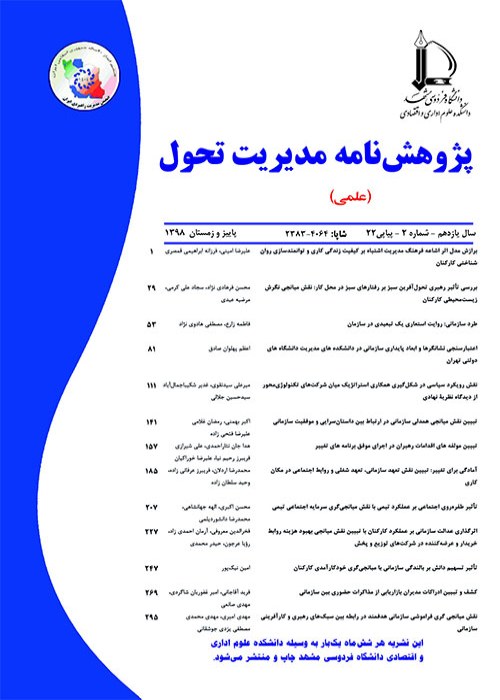Drivers and Outcomes for Inertia in Public Organizations
Author(s):
Article Type:
Research/Original Article (دارای رتبه معتبر)
Abstract:
1-
2- THEORETICAL FRAMEWORK
In physics, inertia is the state of an object to resist change in the speed or direction of movement. The organization literature has defined it as the organization's resistance to environmental changes. The background of this organizational-level construct is rooted in different theories such as open systems, learning, political and social systems, and organizational culture. In regard to conceptualizing, scholars have considered three components of insight, action, and psychological for organizational inertia. The current research typically adds to the literature on inertia in public organizations of developing countries. In addition, it identifies and examines the factors affecting organizational inertia.
3-
4- RESULTS &
5- CONCLUSIONS & SUGGESTIONS
The research finding includes a substantive theory for causes and consequences of organizational inertia resulting from our close connection with the population under study. The practical and research implications of the research are also discussed.
INTRODUCTION
In developing countries, most public organizations for urban services experience inactivity, stagnation, and inflexibility, leading them to inefficiency, poor service delivery, poor urban integration, and dissatisfaction among citizens. This condition is known as organizational inertia. The current research aims to identify the causes and consequences of this phenomenon for urban service organizations in Mashhad city. This research is a qualitative study based on the grounded theory with an emerging approach as its strategy. Despite the acknowledged importance of this problem and the necessity of addressing it, little research has been done in this field. On the one hand, previous scholars have mainly examined the financial outcomes of organizational inertia by conducting quantitative studies, while its antecedents remain unclear. On the other hand, the causes and consequences of this organizational phenomenon are expected to be different in various cultural contexts, structures, and even industries. Accordingly, the primary purpose of the current research is to explore the organizational inertia in the context of Iranian public organizations.2- THEORETICAL FRAMEWORK
In physics, inertia is the state of an object to resist change in the speed or direction of movement. The organization literature has defined it as the organization's resistance to environmental changes. The background of this organizational-level construct is rooted in different theories such as open systems, learning, political and social systems, and organizational culture. In regard to conceptualizing, scholars have considered three components of insight, action, and psychological for organizational inertia. The current research typically adds to the literature on inertia in public organizations of developing countries. In addition, it identifies and examines the factors affecting organizational inertia.
3-
METHODOLOGY
To collect the qualitative data, some interviews were conducted among experienced managers of Mashhad municipality, members of the city council, and university professors. The interviewees were identified by a purposeful sampling method and studied using semi-structured interviews, which continued until the theoretical saturation. Grounded theory with three stages of open, central, and selective coding was used to analyze the obtained data.4- RESULTS &
DISCUSSION
The findings of the research indicated that the causes for organizational inertia are as internal (including the lack of identification and prioritization of city issues, non-dynamic and non-strategic policies of the organization, lack of strategic thinking culture in the organization, existence of cumbersome and outdated laws, lack of planning and in the result of weakness in the executive affairs of the city, failure to use the results of research projects and transformation programs, inertia in managers, weakness in the competencies of managers, lack of motivation to change in employees, risk aversion and laziness of employees, weakness in designing human resources systems that encourage dynamism, defects in knowledge management systems), contextual (the size of the organization, the bare structure, the city management council structure, the temporary nature of the managers' management period, the city council's preoccupation with daily affairs instead of managing affairs, the lack of a competitive environment), urban (poor synchronization of citizens with developments in the provision of urban services, inconsistency and disorganization in city affairs and the absence of an integrated urban management system, the complexity of city issues and inconsistency between organizations involved in urban services), and political (political space governing the organization, requirements beyond the duties of the municipality, etc disproportionate to the municipal infrastructure from other institutions, demands of extra-organizational pressure groups). Furthermore, its consequences are determined to be at three levels: intra-organizational (low effectiveness, poor performance, low innovation), social (dissatisfaction, distrust, reduced participation), and inter-organizational or city (competitiveness with other cities).5- CONCLUSIONS & SUGGESTIONS
The research finding includes a substantive theory for causes and consequences of organizational inertia resulting from our close connection with the population under study. The practical and research implications of the research are also discussed.
Keywords:
Language:
Persian
Published:
Transformation Managemet Journal, Volume:15 Issue: 1, 2024
Pages:
1 to 39
magiran.com/p2679589
دانلود و مطالعه متن این مقاله با یکی از روشهای زیر امکان پذیر است:
اشتراک شخصی
با عضویت و پرداخت آنلاین حق اشتراک یکساله به مبلغ 1,390,000ريال میتوانید 70 عنوان مطلب دانلود کنید!
اشتراک سازمانی
به کتابخانه دانشگاه یا محل کار خود پیشنهاد کنید تا اشتراک سازمانی این پایگاه را برای دسترسی نامحدود همه کاربران به متن مطالب تهیه نمایند!
توجه!
- حق عضویت دریافتی صرف حمایت از نشریات عضو و نگهداری، تکمیل و توسعه مگیران میشود.
- پرداخت حق اشتراک و دانلود مقالات اجازه بازنشر آن در سایر رسانههای چاپی و دیجیتال را به کاربر نمیدهد.
In order to view content subscription is required
Personal subscription
Subscribe magiran.com for 70 € euros via PayPal and download 70 articles during a year.
Organization subscription
Please contact us to subscribe your university or library for unlimited access!


